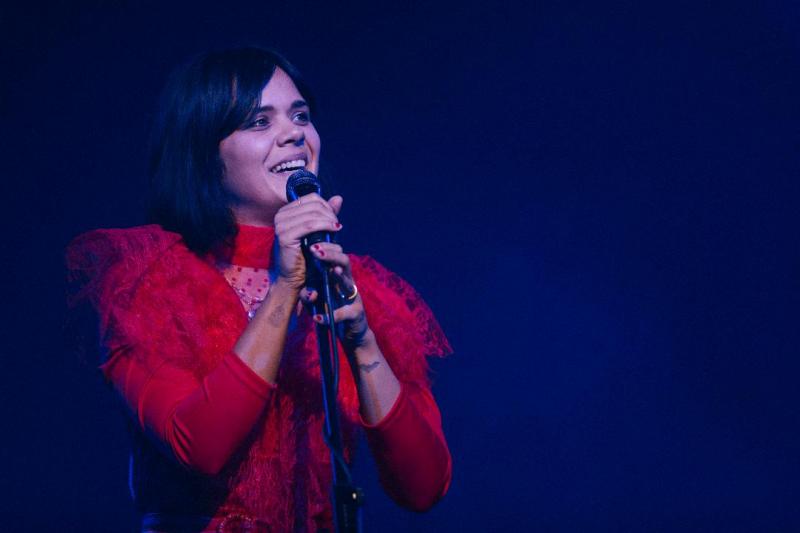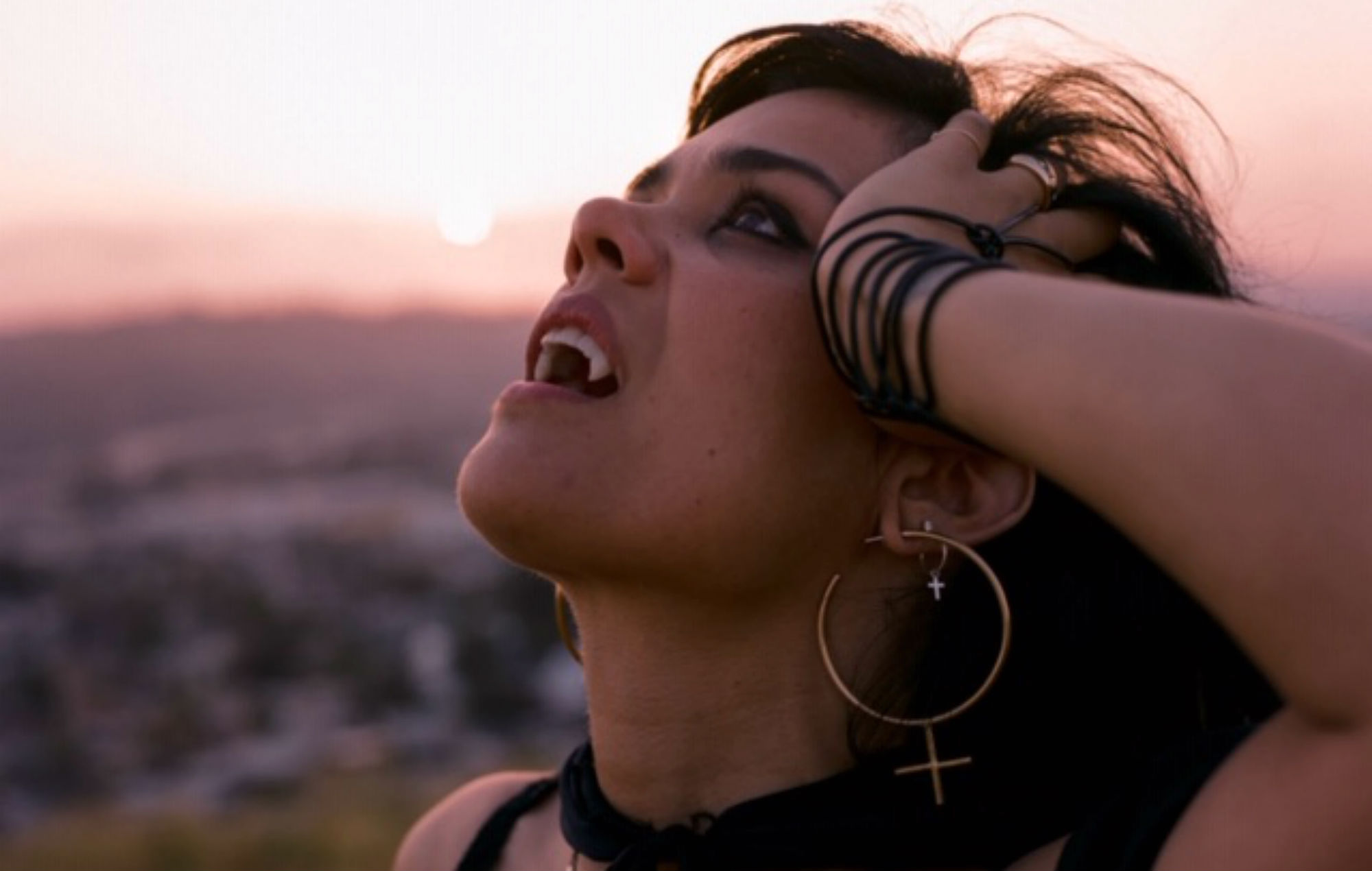Bat for Lashes, St Bartholomew’s Church, Brighton review – a heartfelt homecoming | reviews, news & interviews
Bat for Lashes, St Bartholomew’s Church, Brighton review – a heartfelt homecoming
Bat for Lashes, St Bartholomew’s Church, Brighton review – a heartfelt homecoming
Natasha Khan conjures LA pop myths and South Coast ghosts

Natasha Khan is ending this intimate UK tour where her dreams first took shape. Study at the University of Brighton began 12 years in the bohemian town, and her twice Mercury-nominated, mythology-minded pop life.
Khan’s fifth album as Bat for Lashes, Lost Girls, digs still further back, into a 1980s childhood where racism and her parents’ divorce encouraged deep immersion in The Lost Boys’ slick daylight vampires, Spielberg’s golden suburbs and grand synth glides. Now living in LA as an aspiring filmmaker, present circumstances and old fantasies have usefully fused in its narrative of a female vampire biker gang.
Lost Girls’ widescreen sensuality and nostalgia is heavily mined, as twin synths and Khan’s voice resonate in the faraway rafters. The consistent threads leading to it are, though, also woven in. Still wearing the red dress of her persona in previous album The Bride, so like something from an Angela Carter fairy tale, two of its songs gain new meaning now. Khan is inspired by her Brighton return to precede “Close Encounters” with a student poem, “Missing Time”, which clarifies its theme of alien abduction as trauma metaphor.
 Khan’s “ode to the English countryside”, “Land’s End”, is then sung by an LA artist missing home’s “fog and rain”. Her exploration of the “eerie” Dartmoor landscape which inspired it, she explains, ended with her equally unsettling, cloaked male guide encouraging “a blessing and a prayer” at an ancient rowan tree. Guitar now in hand, she sings of escaping “city lights” to let “my soul be free and spirit fly”. Her open-minded, all-embracing attitude to religion, spirituality, sexuality and myth feels right at home with a golden statue of Christ hanging above her, and stage lamps which glow like candles. It could be a wildly non-denominational, semi-secular Evensong.
Khan’s “ode to the English countryside”, “Land’s End”, is then sung by an LA artist missing home’s “fog and rain”. Her exploration of the “eerie” Dartmoor landscape which inspired it, she explains, ended with her equally unsettling, cloaked male guide encouraging “a blessing and a prayer” at an ancient rowan tree. Guitar now in hand, she sings of escaping “city lights” to let “my soul be free and spirit fly”. Her open-minded, all-embracing attitude to religion, spirituality, sexuality and myth feels right at home with a golden statue of Christ hanging above her, and stage lamps which glow like candles. It could be a wildly non-denominational, semi-secular Evensong.
One gorgeous, stark ballad, “Daniel”, is then paired with her best, “Laura”, a classic hit still awaiting its moment. Khan stands at the mic to honour the song’s profound party girl, willing her out of her subsequent comedown into still hedonistic glory, where she can “dance on the tables again”. The melody’s mellow flow adds to a kindly reverence for this fallen star, still riding high in her heart. Based on a friend it uplifted and Warhol’s doomed Superstars, “Laura” is another heightened pop myth.
The final element in a show which promiscuously rummages around Khan’s pop-culture subconscious is three heartfelt 1980s covers. Don Henley’s “The Boys of Summer” and Cyndi Lauper’s (and Roy Orbison’s) “I Drove All Night” fill in Lost Girls’ hinterland. Unironically venerating a grandiose era, her voice sinks low into smoky sultriness then soars, leaving the songs’ emotional lines simply lucid. Kate Bush’s vital example is honoured with “This Woman’s Work”, with the person who introduced her to it when she was 12 in the audience. Lauper’s poised feminine power – “I drove all night to make love to you/Is that alright?” – equals Bush’s insistence on restoring emotional loss: “Give me these moments back. Give them back to me.”
Khan’s stripped back format in this vast building contains her own pop power, letting it simmer, slow and stately. The covers demonstrate the grateful generosity of an artist just turned 40, but essentially unchanged from the dreaming student she was. That girl’s ghost is invoked so often that she can almost be glimpsed.
rating
Explore topics
Share this article
The future of Arts Journalism
You can stop theartsdesk.com closing!
We urgently need financing to survive. Our fundraising drive has thus far raised £49,000 but we need to reach £100,000 or we will be forced to close. Please contribute here: https://gofund.me/c3f6033d
And if you can forward this information to anyone who might assist, we’d be grateful.

Subscribe to theartsdesk.com
Thank you for continuing to read our work on theartsdesk.com. For unlimited access to every article in its entirety, including our archive of more than 15,000 pieces, we're asking for £5 per month or £40 per year. We feel it's a very good deal, and hope you do too.
To take a subscription now simply click here.
And if you're looking for that extra gift for a friend or family member, why not treat them to a theartsdesk.com gift subscription?
more New music
 Album: Night Tapes - portals//polarities
Estonian-voiced, London-based electro-popsters debut album marks them as one to watch for
Album: Night Tapes - portals//polarities
Estonian-voiced, London-based electro-popsters debut album marks them as one to watch for
 Album: Mulatu Astatke - Mulatu Plays Mulatu
An album full of life, coinciding with a 'farewell tour'
Album: Mulatu Astatke - Mulatu Plays Mulatu
An album full of life, coinciding with a 'farewell tour'
 Music Reissues Weekly: Sly and the Family Stone - The First Family: Live At Winchester Cathedral 1967
Must-have, first-ever release of the earliest document of the legendary soul outfit
Music Reissues Weekly: Sly and the Family Stone - The First Family: Live At Winchester Cathedral 1967
Must-have, first-ever release of the earliest document of the legendary soul outfit
 Album: Robert Plant - Saving Grace
Mellow delight from former Zep lead
Album: Robert Plant - Saving Grace
Mellow delight from former Zep lead
 Brìghde Chaimbeul, Round Chapel review - enchantment in East London
Inscrutable purveyor of experimental Celtic music summons creepiness and intensity
Brìghde Chaimbeul, Round Chapel review - enchantment in East London
Inscrutable purveyor of experimental Celtic music summons creepiness and intensity
 Album: NewDad - Altar
The hard-gigging trio yearns for old Ireland – and blasts music biz exploitation
Album: NewDad - Altar
The hard-gigging trio yearns for old Ireland – and blasts music biz exploitation
 First Person: Musician ALA.NI on how thoughts of empire and reparation influenced a song
She usually sings about affairs of the heart - 'TIEF' is different, explains the star
First Person: Musician ALA.NI on how thoughts of empire and reparation influenced a song
She usually sings about affairs of the heart - 'TIEF' is different, explains the star
 Album: The Divine Comedy - Rainy Sunday Afternoon
Neil Hannon takes stock, and the result will certainly keep his existing crowd happy
Album: The Divine Comedy - Rainy Sunday Afternoon
Neil Hannon takes stock, and the result will certainly keep his existing crowd happy
 Music Reissues Weekly: Robyn - Robyn 20th-Anniversary Edition
Landmark Swedish pop album hits shops one more time
Music Reissues Weekly: Robyn - Robyn 20th-Anniversary Edition
Landmark Swedish pop album hits shops one more time
 Album: Twenty One Pilots - Breach
Ohio mainstream superstar duo wrap up their 10 year narrative
Album: Twenty One Pilots - Breach
Ohio mainstream superstar duo wrap up their 10 year narrative
 Album: Ed Sheeran - Play
A mound of ear displeasure to add to the global superstar's already gigantic stockpile
Album: Ed Sheeran - Play
A mound of ear displeasure to add to the global superstar's already gigantic stockpile
 Album: Motion City Soundtrack - The Same Old Wasted Wonderful World
A solid return for the emo veterans
Album: Motion City Soundtrack - The Same Old Wasted Wonderful World
A solid return for the emo veterans

Add comment